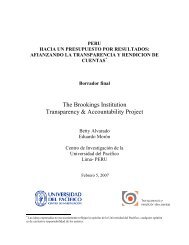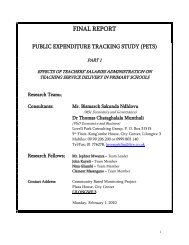Provider Purchasing and Contracting for Health Services_The Case
Provider Purchasing and Contracting for Health Services_The Case
Provider Purchasing and Contracting for Health Services_The Case
Create successful ePaper yourself
Turn your PDF publications into a flip-book with our unique Google optimized e-Paper software.
Table 10: Expenditure per<strong>for</strong>mance on selected cost items <strong>for</strong> DHMTs<br />
2005 2007<br />
Cost Item Target Actual Variance Target Actual Variance<br />
Allowances 44% 57% 98% 10% 57% 82%<br />
Drugs 12% 7% -8% 31% 12% 1%<br />
Maintenance 14% 17% 24% 21% 5% -3%<br />
Training 3% 2% -3% 4% 7% 9%<br />
Capital 26% 17% -12% 35% 19% 11%<br />
Total 100% 100% 100% 100% 100% 100%<br />
Total<br />
(millions of<br />
Zambian<br />
kwachas) 1,134 1,484 — 1,284 3,739 2,455<br />
DMHTs = District <strong>Health</strong> Management Teams.<br />
In response to underfunding <strong>and</strong> delays in disbursements, most of the providers observed that<br />
they cut down on expenditure in non-priority areas such as payment of utility bills, quality of<br />
food given to patients, <strong>and</strong>, in some instances, allowances to staff members. In addition,<br />
providers tend to get goods <strong>and</strong> services from suppliers <strong>and</strong> only pay when they have funds<br />
available.. In some instances, hospitals enter into debt swaps to liquidate their debt by<br />
providing health services to creditors.<br />
Generally, inadequate funding has a negative impact on adherence to targets <strong>and</strong>,<br />
consequently, quality <strong>and</strong> equity of access. Some managers stated that, with inadequate<br />
funding, they cannot af<strong>for</strong>d to buy essential drugs once there is a stock-out or maintain the<br />
laboratory <strong>and</strong> theater equipment. As a result, they have either to provide prescriptions to<br />
patients or refer them to other facilities, thereby compromising the quality of care provided.<br />
Even in cases where an improvement in disbursements was noted, the respondents observed<br />
that it was too early to judge the impact on the quality of care. This is further supported by<br />
the empirical data, which indicate that staffing levels, bed occupancy rates, <strong>and</strong> patients’<br />
length of stay have remained fairly unchanged over the years (see appendix 2).<br />
Regarding procurements, the responses were mixed. Most managers noted that the<br />
procurement <strong>and</strong> delivery of accurate drugs from MSL have slightly improved. However,<br />
some providers complained that the drugs are sometimes inadequate compared with the<br />
Central Board of <strong>Health</strong> period. <strong>The</strong> increased reliability of disbursements has led to<br />
improved local procurements, while the use of internally generated funds has remained the<br />
same. On the other h<strong>and</strong>, the delivery of supplies procured from the Ministry of <strong>Health</strong> has<br />
become less efficient.<br />
Engagement of new staff <strong>and</strong> staff motivation<br />
<strong>The</strong> responsibility of employing health staff under the Central Board of <strong>Health</strong> was delegated<br />
to the District <strong>Health</strong> Boards <strong>and</strong> the Hospital Management Boards. <strong>The</strong> managers noted the<br />
hiring of health staff was easier under the boards than it is now. Moreover, they stated that,<br />
unlike the board system which allowed managers to employ health staff as the need arose, the<br />
system is now more bureaucratic, resulting in delays of between three <strong>and</strong> six months in the<br />
hiring of health staff. This has adversely affected service delivery.<br />
49
















